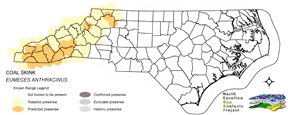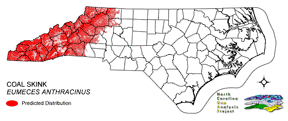
| Taxa: |
| Order: |
| Family: |
| Reptilia |
| Squamata |
| Scincidae |
| NatureServe Global Rank: |
| NatureServe State (NC) Rank: |
| G5 |
| S3 |
| Federal Status: |
| NC State Status: |
| --- |
| W2 |


| Land Unit |
| US Fish & Wildlife Service |
| US Forest Service |
| US National Park Service |
| US Department of Defense |
| NC State Parks |
| NC University System |
| NC Wildlife Res. Com. |
| NC Forest Service |
| NC Div. of Coastal Mgmt. |
| Local Governments |
| Non-Governmental Org. |
| Other Public Lands |
| Private Lands |
| GAP Status 1-2 |
| All Protected Lands |
| Statewide |
| Hectares |
| 0.00 |
| 363,680.19 |
| 472.59 |
| 102,838.95 |
| 12,826.62 |
| 70.47 |
| 15,329.70 |
| 3,092.94 |
| 0.00 |
| 6,661.62 |
| 5,508.63 |
| 53.37 |
| 1,432,708.29 |
| 162,839.25 |
| 509,835.06 |
| 1,943,243.37 |
| Acres |
| 0.00 |
| 898,673.15 |
| 1,167.80 |
| 254,120.53 |
| 31,695.26 |
| 174.14 |
| 37,880.51 |
| 10,724.77 |
| 0.00 |
| 16,461.22 |
| 13,612.12 |
| 131.88 |
| 3,540,298.60 |
| 405,466.42 |
| 1,262,911.57 |
| 4,804,939.95 |
| % of Dist. on |
| Prot. Lands |
| 0.0 % |
| 71.3 % |
| < 0.1 % |
| 20.2 % |
| 2.5 % |
| < 0.1 % |
| 3.0 % |
| 0.6 % |
| 0.0 % |
| 1.0 % |
| 1.0 % |
| < 0.1 % |
| 0.0 % |
| 31.9 % |
| ----- |
| ----- |
| % of Dist. on |
| All Lands |
| 0.0 % |
| 18.7 % |
| < 0.1 % |
| 5.3 % |
| 0.7 % |
| < 0.1 % |
| 0.8 % |
| 0.2 % |
| 0.0 % |
| 0.3 % |
| 0.3 % |
| < 0.1 % |
| 73.7 % |
| 8.4 % |
| ----- |
| ----- |
|
Some authors consider the coal skink to prefer hillsides in moist settings often in the vicinity of springs, swamps, creeks, and bogs where an abundance of leaf litter and loose stones is present (Collins 1974, Conant 1975). Other sites where the skink has been found (limestone ledges, dry leaves beneath rock ledges, beneath flat slabs of sandstone, under
rocks in grassy cut over area of hardwoods and under rocks in slope of road cut through a mixed forest) appear to be less associated with water. In North Carolina, mesic forested rocky slopes, exposed road banks, and grassy places are used (Palmer and Braswell 1995). Generally shelter under rocks in the area of a sunlit opening in the forest (Mitchell 1994). Rotten logs, brush piles, and stacks of lumber also make good shelter (Green and Pauley 1987). NATURE SERVE GLOBAL HABITAT COMMENTS: Humid wooded areas with abundant leaf litter and loose rocks; vicinity of springs, swamps, and bogs; rocky bluffs above creek valleys; dry shale barrens (West Virginia). Often under logs and rocks near water. May take refuge in water. One nest was under a piece of shale (Mount 1975). |
| Code | Name | Description | NC Natural Heritage Program Equivalent |
| 230 | Piedmont Mesic Forest | American Beech - Red Oak - White Oak Forests. | Mesic Mixed Hardwood |
| 384 | Piedmont/Mountain Mixed Bottomland Hardwood Forests | Includes temporarily to seasonally forests dominated by hardwood species. Hardwoods include sweetgum, red maple, sycamore which co-occur in a mosaic of bottomland and levee positions. Includes alluvial hardwood forests in the mountains. Hemlock and white pine may occur as inclusions, but are generally mapped separately. | Piedmont/Mountain Alluvial Forest, Piedmont/Mountain Levee Forest |
| 383 | Piedmont Mixed Successional Forest | Generally loblolly mixed with successional hardwoods. Sweetgum, tulip poplar and red maple are common co-dominants in these successional forests. | No equivalent |
| 228 | Piedmont Dry-Mesic Oak and Hardwood Forests | Primarily oak dominated forests, white oak is often dominant, with co-dominants including . Also represented by sweetgum and tulip poplar dominated forests. | Dry Mesic Oak Hickory Forest, Basic Oak Hickory Forest, Dry Oak Hickory Forest |
| 222 | Piedmont Dry-Mesic Pine Forests | Loblolly dominated forests resulting from succession following clearing. This type occurs on all moisture regimes following disturbance with the exception of the extremely xeric sites. | No equivalent |
| 382 | Dry Mesic Oak Pine Forests | Mixed forests of the coastal plain and piedmont. Includes loblolly pine with white, southern red and/or post oak and loblolly with water oak. On basic sites of the piedmont, eastern red cedar may co-occur with post, black, and blackjack oaks. | Dry Mesic Oak Hickory Forest, Xeric Hard Pan Forest, Chestnut Oak Forest, Dry Mesic Oak Hickory Forest, Dry Oak Hickory Forest |
| 21 | Coniferous Cultivated Plantation (natural / planted) | Managed pine plantations, densely planted. Most planted stands are loblolly, but slash and longleaf occur as well. | No equivalent |
| 51 | Deciduous Cultivated Plantation | Planted deciduous trees. Includes sweetgum and sycamore plantations. | No equivalent |
| 36 | Successional Deciduous Forests | Regenerating deciduous trees with a shrub stature. Commonly dominated by sweetgum, tulip poplars and maples. | No equivalent |
| 517 | Hemlock Floodplain Forest | Alluvial forest with hemlock and/or white pine in mountains and western piedmont. Hydrology is generally temporarily to seasonally flooded. | Canada Hemlock Forest |
| 522 | Northern Hardwoods | High Elevation forests including yellow birch, American beech, and yellow buckeye. Includes forests with Hemlock and Yellow Birch. | Northern Hardwoods Forest, Boulderfield Forest |
| 525 | Appalachian Oak Forest | A variety of oak forest types including Black, White, Scarlet Oaks in dry to mesic situations. Includes forests historically co-dominated by American Chestnut. | High Elevation Red Oak Forest, Montane White Oak Forest |
| 526 | Appalachian Cove Forest | Mixed Mesophytic forests of the mountains. Includes tuliptree, basswood, yellow buckeye and surgar maple. This class is mapped to include cove forests dominated or co-dominated by hemlock. | Rich Cove Forest, Acidic Cove Forest |
| 527 | Appalachian Hemlock | Upland hemlock forests of the moutains region. Vary from side slopes to steep slope positions. | Canada Hemlock Forest |
| 535 | Talus/Outcrops/Cliffs | Includes seep talus slopes with sparce vegetation, as well as outcrops including, granitic outcrops. Some outcrops will have been mapped as barren rock. | No equivalent |
|
Collins, J. T. 1974. Amphibians and reptiles in Kansas. University of Kansas Publication Museum Natural History. Publ. Education Series 1:1-283.
Smith, H. M. 1946. Handbook of lizards. Lizards of the United States and Canada. Cornell univ. Press, Ithaca. xxi + 557 pp. Mitchell, J. C. 1994. The reptiles of Virginia. Washington, DC: Smithsonian Institution Press. Palmer, W. M., and A. L. Braswell. 1995. Reptiles of North Carolina. North Carolina State Museum of Natural Sciences, University of North Carolina Press, Chapel Hill, North Carolina. Conant, R. 1975. A Field Guide to Reptiles and Amphibians of Eastern and Central North America. Second Edition. Houghton Mifflin Company, Boston, Massachusetts. xvii + 429 pp. Mount, R. H. 1975. The Reptiles and Amphibians of Alabama. Auburn University Agricultural Experiment Station, Auburn, Alabama. vii + 347 pp. Behler, J. L., and F. W. King. 1979. The Audubon Society field guide to North American reptiles and amphibians. Alfred A. Knopf, New York. 719 pp. Collins, J. T. 1982. Amphibians and reptiles in Kansas. Second edition. Univ. Kansas Mus. Nat. Hist., Pub. Ed. Ser. 8. xiii + 356 pp. Green, N. B., and T. K. Pauley. 1987. Amphibians and reptiles in West Virginia. University of Pittsburg Press, Pittsburg, Pennsylvania. xi + 241 pp. |
For more information please contact them at:
NC-GAP Analysis Project
Dept. of Zoology, NCSU
Campus Box 7617
Raleigh, NC 27695-7617
(919) 513-2853
www.basic.ncsu.edu/ncgap